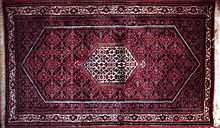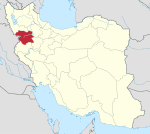Bijar
| Bijar-بيجار | |
|---|---|
 | |
 Bijar-بيجار Location in Iran | |
| Coordinates: 35°52′22″N 47°36′10″E / 35.87278°N 47.60278°ECoordinates: 35°52′22″N 47°36′10″E / 35.87278°N 47.60278°E | |
| Country |
|
| Province | Kurdistan |
| County | Bijar |
| Bakhsh | Central |
| Population (2011) | |
| • Total | 47,926 |
Bījār (Persian: بيجار; Kurdish: بیجاڕ,[1] Bîcar) is a city in and capital of Bijar County, Kurdistan Province, Iran. At the 2011 census, its population was 47,926, in 14,970 families.[2] With an elevation of 1,940 metres, Bijar is called the Roof of Iran.


Bijar is known internationally for its elegant and ancient carpet and rug designs. The term bijar could be a variation of bajar (i.e. city in Kurdish) and the complete name of the city is Bijar-e Garrus (city of Garrus). Among other suggested etymology for bijar are bid-zar (land of willow tree) which is linguistically unlikely. Bijar is known internationally for its elegant and ancient carpet and rug designs.
History
Historically, Bijar has been part of Garrus administration unit. Before the creation of Zanjan province by the Pahlavi regime (after WWI), the wider region of Garrus covered Suhreward, the birth place of Shahab al-Din Suhrewardi, the famous Persian philosopher of illumination.[3]
The city was mentioned in the 15th century as a village belonging to Shah Ismail the first ruler of the Safavid dynasty, Bijar became a town during the 19th century. During World War I it was besieged and occupied by Russian, British, and Ottoman troops.[4]
Architecture
The historical fort of Qam Cheqay in valley of kings (45 km of Bijar) probably dates back to the Median era and it is the oldest castle in the Kurdistan province. The castle has been used until the Sasanid era and it is an example of ancient architecture of Kurdistan.
Another historical building, Emamzadeh Aqil, located in Hasan Abad (Yasukand) 45 km east of Bijar is one of the remaining Saljugi buildings. The square building (6*6.5 m) with the collapsed dome has been home to Islamic religious texts written in Kufi script.
Bijar's bazar, with its unique design is one of the attractions of the city. The roofed bazar built in the Qajar era is much younger than the Safavid era old bazar of Sanadaj. The bazar of Bijar consists of a main north-south roofed pathway and an eastern section (timcheh-e Haj Shahbaz) and a western section (timcheh-e Amir Toman).
Culture
The Iranian Peyam Nur university has opened a branch in Bijar-e Garrus and the Garrus research center is affiliated with the university.
Prominent politicians and army officers in Iranian army have come from Bijar. Amir Nezam Garrusi (1820–1900) was born in Bijar to a Kabudvand family. As the colonel of Garrus regiment, he accompanied Muhammad Ali Shah's unsuccessful Harat campaign. As a diplomat in Paris, he had dinners with the Napeleon and afterwards acted as an Iranian diplomat in Istanbul in Otoman empire. General Garrusi later joined the forces for the 1880 suppression of Kurdish uprising by the Naqshibandi Shaikh Obeidulah. He also played a negative part in murdering Cewer Agha, the predecessor of Simko, the Kurdish leader.
Dr. Ramezanzadeh, the spokesman of Khatami government has family connections to Bijar. Mr Shahriari, a prominent Iranian TV personality comes from Bijar.
In June 2008, 21 year old Hana Abdi, former student of Payam Nur University of Bijar, and member of women's association of AzarMerh in Kurdistan has been sentenced to a 5 year prison term. According to Mr Sharif, her attorney, Iranian revolutionary court has charged her with threat against national security.
References
- ↑ Bijar can be found at GEOnet Names Server, at this link, by opening the Advanced Search box, entering "-3056389" in the "Unique Feature Id" form, and clicking on "Search Database".
- ↑ "Census of the Islamic Republic of Iran, 1385 (2006)". Islamic Republic of Iran. Archived from the original (EXCEL) on 2011-11-11.
- ↑ Mulla Sadra's Transcendent Philosophy, p. 12, at Google Books
- ↑ Encyclopedia Iranica
| ||||||||||||||||||||||||||||||||||||||||||||||||||||||||||
